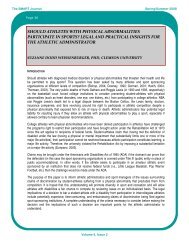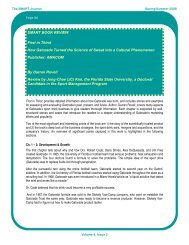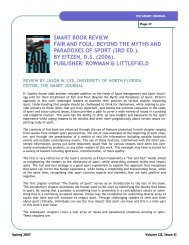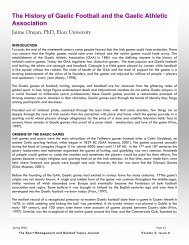examining the body of scholarship in sport management
examining the body of scholarship in sport management
examining the body of scholarship in sport management
You also want an ePaper? Increase the reach of your titles
YUMPU automatically turns print PDFs into web optimized ePapers that Google loves.
SMART Onl<strong>in</strong>e Journal Volume 2, Issu e 1The SMART Journal Fall 2005 Volume 2, Issue 1female and male <strong>sport</strong>s. Table 8 also shows how<strong>the</strong>se results compare to two o<strong>the</strong>r studies on<strong>sport</strong> <strong>management</strong> journals.CONCLUSIONS AND DISCUSSIONBased on <strong>the</strong> f<strong>in</strong>d<strong>in</strong>gs <strong>of</strong> this study, <strong>the</strong> follow<strong>in</strong>gconclusions were drawn. First, this journal hascontributed 233 peer-reviewed empirical researcharticles to <strong>the</strong> <strong>body</strong> <strong>of</strong> literature <strong>in</strong> <strong>sport</strong><strong>management</strong> s<strong>in</strong>ce its <strong>in</strong>ception <strong>in</strong> 1987. Indeed,some have praised <strong>the</strong> journal stat<strong>in</strong>g that it“garnered a high standard <strong>of</strong> <strong>scholarship</strong> <strong>in</strong> arelatively short period <strong>of</strong> time” (Weese, 1995, p.239) and that it “has become <strong>the</strong> major source fordissem<strong>in</strong>at<strong>in</strong>g significant knowledge <strong>in</strong> <strong>the</strong>field” (Parkhouse & Pitts, 2001, p. 7). However,<strong>the</strong> <strong>sport</strong> <strong>management</strong> literature, with this journal<strong>in</strong>cluded, has received criticism for its lack <strong>of</strong> fullrepresentation <strong>of</strong> <strong>sport</strong> <strong>management</strong> content areasand <strong>sport</strong> bus<strong>in</strong>ess <strong>in</strong>dustry segments (Olafson,1990; Paton, 1987; Pedersen & Pitts, 2001; Pitts,2001; Slack, 1996; Soucie & Doherty, 1996). Thef<strong>in</strong>d<strong>in</strong>gs <strong>of</strong> <strong>the</strong> current study provide empiricalevidence that supports <strong>the</strong>se claims. Although<strong>the</strong>re was at least one article whose content wascategorized <strong>in</strong>to each <strong>of</strong> <strong>the</strong> content areasidentified, <strong>the</strong>re was a disproportionate number <strong>of</strong>articles on each area, and a wide marg<strong>in</strong> between<strong>the</strong> content area with <strong>the</strong> most number <strong>of</strong> articles(38% <strong>of</strong> <strong>the</strong> articles focused on <strong>management</strong> andorganizational skills <strong>in</strong> <strong>sport</strong>) and <strong>the</strong> second mostnumber <strong>of</strong> articles (18% focused on <strong>sport</strong>market<strong>in</strong>g). Beyond those two categories, <strong>the</strong>percent <strong>of</strong> articles focused on a content area was10 percent and lower. Therefore, it can beconcluded that <strong>the</strong>re has been an <strong>in</strong>equitableamount <strong>of</strong> focus on <strong>the</strong> <strong>sport</strong> <strong>management</strong> contentareas.Second, <strong>the</strong> f<strong>in</strong>d<strong>in</strong>gs <strong>of</strong> this study are similar to<strong>the</strong> f<strong>in</strong>d<strong>in</strong>gs <strong>of</strong> o<strong>the</strong>r studies on s<strong>in</strong>gular journals<strong>in</strong> <strong>sport</strong> <strong>management</strong> and ano<strong>the</strong>r study onconference proceed<strong>in</strong>gs topics. Taken <strong>in</strong>dividually,each study cannot be <strong>in</strong>ferred to <strong>the</strong> wholepopulation with a high degree <strong>of</strong> confidence.However, when <strong>the</strong> f<strong>in</strong>d<strong>in</strong>gs <strong>of</strong> all four studies areconsidered toge<strong>the</strong>r, that degree <strong>of</strong> confidencerises. Given that four studies represent a greaterpercentage <strong>of</strong> <strong>the</strong> whole <strong>body</strong> <strong>of</strong> literature, <strong>the</strong>rePage 43is more evidence that <strong>the</strong> <strong>sport</strong> <strong>management</strong>literature appears to be heavily lopsided.Therefore, <strong>the</strong>re is <strong>in</strong>creas<strong>in</strong>g evidence to support<strong>the</strong> claims that <strong>sport</strong> <strong>management</strong> literature doesnot yet reflect or represent <strong>the</strong> many differentsegments <strong>of</strong> <strong>the</strong> <strong>sport</strong> bus<strong>in</strong>ess <strong>in</strong>dustry, and aredisproportionately focused on <strong>in</strong>tercollegiateathletics and a few pr<strong>of</strong>essional <strong>sport</strong>s. As noted,<strong>the</strong> f<strong>in</strong>d<strong>in</strong>gs <strong>of</strong> this study are similar to <strong>the</strong> results<strong>of</strong> <strong>the</strong> Pedersen & Pitts (2001) study on ano<strong>the</strong>r<strong>sport</strong> <strong>management</strong> journal, <strong>the</strong> Sport Market<strong>in</strong>gQuarterly. However, <strong>the</strong> current study found aslightly higher focus on “participant <strong>sport</strong>” (13.3%)than “pr<strong>of</strong>essional <strong>sport</strong>” (12.8%). Pedersen andPitts found that <strong>the</strong> segments <strong>of</strong> <strong>the</strong> <strong>in</strong>dustry onwhich most articles were focused <strong>in</strong>cludedpr<strong>of</strong>essional <strong>sport</strong> (36%), <strong>sport</strong> market<strong>in</strong>g (19%),<strong>in</strong>tercollegiate athletics (12%), participant <strong>sport</strong>(8%), <strong>sport</strong> <strong>management</strong> and market<strong>in</strong>g agencies(7%), and <strong>sport</strong> communication (7%). The results<strong>of</strong> <strong>the</strong> current study show that <strong>the</strong> largest percent<strong>of</strong> articles were studies on <strong>in</strong>tercollegiate athletics(92 articles, 40%) and that <strong>the</strong> next largestpercent was a distant 13.3% and was participant<strong>sport</strong>, with pr<strong>of</strong>essional <strong>sport</strong> at 12.8%. Inaddition, <strong>the</strong>se results are similar to <strong>the</strong> f<strong>in</strong>d<strong>in</strong>gs<strong>of</strong> Mondello and Pedersen (2003) <strong>in</strong> <strong>the</strong>ir study onano<strong>the</strong>r <strong>sport</strong> <strong>management</strong> journal, <strong>the</strong> Journal <strong>of</strong>Sports Economics. Yet, <strong>the</strong> results <strong>of</strong> that studyshow an overwhelm<strong>in</strong>g disparity. Mondello &Pedersen reported that <strong>the</strong> <strong>in</strong>dustry segment focusbreakdown was 80% on pr<strong>of</strong>essional <strong>sport</strong>s (andthat that broke down <strong>in</strong>to 51.8% on <strong>the</strong> men’s ‘bigfour’ <strong>sport</strong>s while 28.2% was on o<strong>the</strong>r pr<strong>of</strong>essional<strong>sport</strong>s) and 7.1% on college athletics.Third, although females make up roughly half <strong>of</strong><strong>the</strong> population <strong>in</strong> general and <strong>in</strong>creas<strong>in</strong>g numbers<strong>in</strong> <strong>sport</strong>s, <strong>the</strong> results <strong>of</strong> this study reveals that thiscannot be said for <strong>the</strong> gender focus <strong>of</strong> <strong>the</strong> articles<strong>in</strong> JSM. Of those articles with an identifiablegender focus, more than twice <strong>the</strong> number andpercent <strong>of</strong> articles were focused on male <strong>sport</strong>s;however, <strong>the</strong> largest percent (58%) focused on bothgenders. This f<strong>in</strong>d<strong>in</strong>g is also similar to previousresearch f<strong>in</strong>d<strong>in</strong>gs. Pedersen and Pitts (2001)reported that <strong>the</strong> gender focus <strong>of</strong> articles <strong>in</strong> <strong>the</strong>SMQ was 28% on male <strong>sport</strong>s and 8% on femaleTHE SMART JOURNAL








